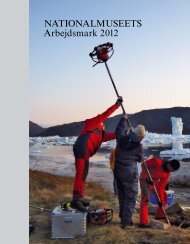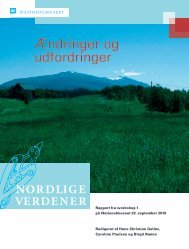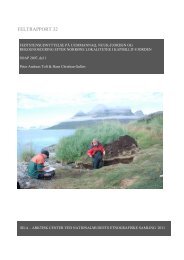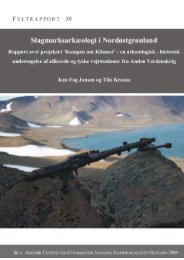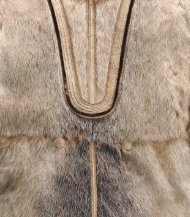The Border of Farming and the Cultural Markers - Nordlige Verdener
The Border of Farming and the Cultural Markers - Nordlige Verdener
The Border of Farming and the Cultural Markers - Nordlige Verdener
You also want an ePaper? Increase the reach of your titles
YUMPU automatically turns print PDFs into web optimized ePapers that Google loves.
38<br />
Photo Ditlev L. Mahler 2011.<br />
General introduction<br />
<strong>The</strong> object <strong>of</strong> <strong>the</strong> three years research<br />
project Shetl<strong>and</strong> – <strong>the</strong> <strong>Border</strong> <strong>of</strong> <strong>Farming</strong><br />
4000-3000 B. C. E. is to ga<strong>the</strong>r, analyse<br />
<strong>and</strong> document <strong>the</strong> Shetl<strong>and</strong> Isl<strong>and</strong>’s Neolithic<br />
material in order to deepen our<br />
underst<strong>and</strong>ing <strong>of</strong> <strong>the</strong> Neolithic process<br />
<strong>and</strong> <strong>the</strong> social impact on <strong>the</strong>n existing<br />
societies within <strong>the</strong> period, both on <strong>the</strong><br />
Shetl<strong>and</strong> Isl<strong>and</strong>s as well as in Sc<strong>and</strong>inavia.<br />
Newer research suggests that <strong>the</strong><br />
Shetl<strong>and</strong> Isl<strong>and</strong>s became Neolithic by<br />
several steps over a period <strong>of</strong> time<br />
(Mahler 2011: 13). <strong>The</strong> research project<br />
aims to survey <strong>the</strong> sequence <strong>and</strong> nature<br />
<strong>of</strong> <strong>the</strong> various elements in this process<br />
as a basis for a comparative analysis <strong>of</strong><br />
<strong>the</strong> Sc<strong>and</strong>inavian agrarian societies <strong>and</strong><br />
<strong>the</strong>ir expansion.<br />
<strong>The</strong> project also applies l<strong>and</strong>scape analysis<br />
in order to expose <strong>the</strong> ritual l<strong>and</strong>scape<br />
as well as cultural markers in <strong>the</strong><br />
same l<strong>and</strong>scape. <strong>The</strong> project could provide<br />
us with a whole new perspective<br />
on <strong>the</strong> Neolithic process in <strong>the</strong> area <strong>and</strong><br />
provide comparative material with regards<br />
to Sc<strong>and</strong>inavia. In <strong>the</strong> light <strong>of</strong> <strong>the</strong><br />
well documented, early Neolithic Sou<strong>the</strong>rn<br />
Sc<strong>and</strong>inavian material it should be<br />
possible to create a chronological order<br />
as a basis for an underst<strong>and</strong>ing <strong>of</strong> <strong>the</strong><br />
Neolithic process in general <strong>and</strong> on <strong>the</strong><br />
Shetl<strong>and</strong> Isl<strong>and</strong>s specifically.<br />
With regards to <strong>the</strong> expansion <strong>of</strong> agrarian<br />
societies, <strong>the</strong> Shetl<strong>and</strong> Isl<strong>and</strong>s were<br />
<strong>the</strong> ultimate North Western boundary<br />
lying 60° nor<strong>the</strong>rn latitude. Within <strong>the</strong><br />
time span 4.000-3.000 B.C.E an agrarian<br />
culture established itself on <strong>the</strong> Shetl<strong>and</strong><br />
Isl<strong>and</strong>s with material <strong>and</strong> immaterial<br />
elements such as ritual practices<br />
characteristic <strong>of</strong> <strong>the</strong> Neolithic process in<br />
all <strong>of</strong> Europe. Amongst <strong>the</strong>se elements<br />
are monumental sites such as <strong>the</strong> chambered<br />
cairn at Caldback, Unst, which<br />
probably is <strong>the</strong> Nor<strong>the</strong>rnmost passage<br />
grave <strong>of</strong> Europe still in existence. And<br />
also polished tools <strong>of</strong> ritual use such as<br />
point butted felsit axes <strong>and</strong> geometrically<br />
ornamented ceramic ware. A relatively<br />
large population established, at<br />
an early date, stone boundaries around<br />
<strong>the</strong>ir fields <strong>and</strong> across <strong>the</strong> l<strong>and</strong>scape in<br />
Fig. 2: <strong>The</strong> chambered cairn at Caldback, Unst,<br />
seen from South East. <strong>The</strong> passage grave could<br />
be <strong>the</strong> Nor<strong>the</strong>rn most passage grave in Europe<br />
still in existence.




